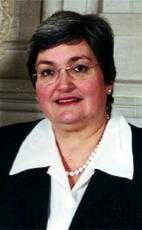Madam Speaker, I am pleased to rise today and participate in the debate on Motion No. 85.
When I first reviewed this motion I could not pronounce the word phthalates and I think most Canadians on seeing the word might have the same difficulty. I undertook not only to learn the correct pronunciation but also to try to understand what was being proposed and why it was being proposed.
I want to thank the people at Health Canada for sharing with me the evidence, information and work they have undertaken.
Health Canada has the responsibility for ensuring the safety of products. I am convinced the department will take appropriate action as required to safeguard our children. I say that not just as a member of the House of Commons but as a grandmother. I have three grandchildren under the age of three and a half who also put things in their mouths. If they are putting things that are hazardous to their health in their mouths then I do not believe a label is adequate protection. That is why I have some concerns about the private member's motion before us today.
Health Canada has been concerned about phthalates since the 1980s. Last fall the environmental organization Greenpeace released a report on a group of chemicals. These are polyvinylchlorides or PVC plastics. PVC and plastics are contained not only in toys but in many things found in our everyday lives, from the seats in our cars to coverings on notebooks. The Greenpeace report actually set off the latest round in what is a longstanding debate on the potential hazards of PVCs in children's toys and elsewhere.
Today I would like to review the Greenpeace claim and inform the House of Health Canada's activities in response to this concern. I have been listening very carefully to the debate and I believe that every member of this House shares the concern about the safety of our children and our grandchildren. We also want to know if substances which we come in contact with in our daily lives have hazards that we should be aware of.
The history of phthalates is very important. According to the Greenpeace study eight of the 63 toys it tested were purchased in Canada. The report claimed that four of the six toys contained phthalate concentrations ranging from 20% to 39%.
Health Canada obtained a copy of the Greenpeace report and departmental officials have studied its findings. It is extremely important to note that the assessment was done in co-operation with international experts in this area. It is not just Canada and the United States but the world is interested in products which may have harmful contaminants.
Officials at Health Canada conducted a field survey and found that 63 toys mentioned in the Greenpeace report were available in Canada. All 63 toys were made in the United States and 38 of the toys are available in Canada.
Health Canada's health protection branch conducted its own tests on three of the four products that Greenpeace had identified as having significant concentrations of phthalates. The tests revealed a similar concentration of phthalates as the tests done by Greenpeace with levels ranging from 3.9% to 26%.
It should be noted that the phthalate identified in both studies is the one known as DINP. This chemical was introduced by toy manufacturers in the United States six years ago to replace another phthalate, DEHP. Why is the difference important? DEHP was thought to be potentially harmful and hazardous to children and was voluntarily taken from the marketplace and replaced with DINP.
Following its usual precautionary approach to potential health hazards, Health Canada expanded its testing and assessment of PVC plastic toys to an additional 30 products that were not on the Greenpeace list. With the exception of an unknown phthalate found in one sample, the only phthalate detected was DINP. Eight additional samples were then bought and tested. Only DINP was detected with very small amounts of DEHP.
These results support my view that private member's Motion No. 85 is premature. I believe it is premature because the scientific evidence is not in and available. I also believe that if the evidence showed that the phthalate DINP is a hazard to children, then labelling would be inadequate. Therefore, I do not believe we should proceed with this motion. It is my understanding that the research will be concluded this spring. The evidence will be there and will be evaluated.
I am convinced that Health Canada will remain vigilant in its quest to ensure that potential health risks which are posed by PVC plastic toys and others will be brought to the attention of all Canadians in an appropriate manner. If it is a health hazard it will be banned and not simply labelled.
The department is continuing to monitor the situation. It is testing plastic toys. As the minister has indicated, Health Canada and this government will take whatever action is necessary to protect the health of Canada's children.
It is important for us to have these debates in the House. One of the concerns I have is that we not unduly alarm people about potential hazards when there is no evidence to support those findings. I await the results of scientific evidence. I would urge all members of this House to make sure they get the facts straight when we are having this debate.
Should the investigations indicate that these additives in vinyl products pose or are likely to pose a risk to young children, I believe the department will not and should not hesitate to take necessary corrective measures. However, it would be irresponsible for us to act without the evidence to suggest that our children are in danger.

